Second Thoughts: Bordeaux Second (And Now Third) Wines Château d’Issan (Margaux 6-Bottle Pack $326) & Château Pédesclaux (Pauillac 6-Bottle Pack $294) + In-Store Tasting ‘Left-Bank Rendez-Vous’ – RSVP
Rather than shedding tears, Bordeaux adds tiers—and classification is what Bordeaux is all about. While the Grand Vin is expected to be the A-game of any château, with technological advancements and an increasingly warm climate, the price of these top-shelf wines has risen with the temperature, and quality is ensured by an ever more rigorous selection of grapes on the sorting table.
Second wines—a tradition begun by Château Margaux in the 17th century—were the logical place to establish grapes deemed unfit for inclusion in the Grand Vin. And since the terroir in which they were grown was often similar, and occasionally identical to the first wines (and generally made by the same vigneron), it stands to reason that the great estates would release these ‘little brother wines’ under some version of their famous name. Château Lafite Rothschild’s second wine, for example, is Carruades de Lafite; Château Margaux’s is Pavillon Rouge du Château Margaux.
This name-game association has a downside, of course: As the prices for a château’s main bottling rose, they found that they could easily command more for second wines as well, and inexorably, these began to be priced beyond the reach of many consumers as well. Especially in the Médoc, the cost of second wines crept up to a price point once paid for the first. Some châteaux found a solution in producing third wines, and although fourth wines are not unheard of, the bulk of a harvest that does end up in one of the three is generally declassified and sold to négociants.
Price Pressure
As mentioned above, any viable business must weigh the needs of customers with their ability to pay for their product, and the cachet associated with First Growths in Bordeaux is so encompassing that maintaining quality outweighs any need for quantity. It’s fair to suggest that for Bordeaux’s most heralded names, second wines are not a bid for publicity, but exist as a vital—and growing—revenue source. In 2010, for example (one of the best years for quality in decades) only 40% of the harvest went into Lafite’s first wine while a full 55% went into Carruades.
In contrast is Château Léoville Barton, who uses about 80% of their grapes for their Grand Vin, a Deuxième Cru. It’s a somewhat unique philosophy, says the late Anthony Barton: “‘We produced some jolly good wines doing things that in the current era would make our oenologist scream. Grapes into one big wooden barrel, crushed by foot in the field. But we made vintages such as 1945 and 1947. The other day I found an invoice for a fiddler who played while we stomped. Now you need velvet gloves for touching the grapes.”
Precise Vinification
Other estates, like Château Pontet-Canet, express a goal of vinifying 100% Grand Vin—a once unreachable star brought closer to earth by advancing technology and better land management. Beyond the biodynamic movement which is sweeping most winemaking regions in the world, Picovale weather stations are increasingly allowing vineyard managers to be proactive in the face of incipient bad weather, especially the dreaded springtime frosts. Experience, formerly the sole means of measuring phenolic ripeness and knowing when to harvest, has guided winemakers in Bordeaux since Roman times, but technology can remove the last traces of guesswork. Brimrose Le Vigneron AOTF-NIR Analyzer calculates and levels of sugar and acidity, bringing groundbreaking insight to the exact time winemakers should be harvesting.
These innovations allow a much more precise product to be bottled, and with the increasing quest for perfection, they are becoming increasingly indispensable, even in a region where tradition is sacred.
Harnessing the Young Vines
Older vines are a legacy among wine growers, and when they reach a certain age, it becomes a point of pride. With an expansive root system and substantial permanent wood, these vines have adapted to their environment and are more resilient to drought and extreme weather. At the same time, they are more prone to disease and damage and produce increasingly smaller yields, and at some point, it no longer makes sense to keep them in commercial production. Maintaining a sustainable economic vineyard means replanting, and in Bordeaux, mature vines are often replaced after about 35 years. After that, it takes between ten and twenty years for a vine’s fruit to reach potential, and a natural outlet for grapes from younger vines is an estate’s second and third wines, where it is expected that the tannins will be a bit coarser and less integrated, but which will mature more quickly than Grand Vin bottlings.
Access to Quality
In fact, the idea that second wines can be enjoyed earlier than their big brothers is one of their main selling points. Great wines may take twenty years to reach their apex; a lesser version may deliver its entire package upon release, or at least, within a few years. Second wines may come from the same winemaker who makes the first, and even the same plots of ground, but the philosophy is different. By using slightly less newsworthy fruit in the second wine rather than the first, the quality of the Grand Vin is expected to remain high; the alternative may to produce more Grand Vin with lesser grapes, but which would consequentially, be available at a lower price. It’s an endless balance, well summarized by Anthony Barton: “While I don’t believe that you can go too far in the search for perfection in wine, you can certainly go too far in search for profits.”
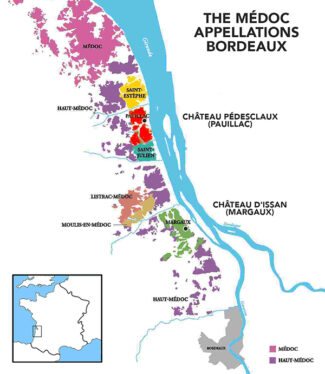
2018 Vintage: Opulent, Sensual and Deeply Colored
Philippe Sereys de Rothschild (owner of Château Mouton Rothschild) compares Vintage 2018 to the legendary ‘59s, which he claims are still near-perfect, with incredible depth and finesse. “It’s always interesting to try to describe a vintage with one word,” he says. “2009 is velvet; 2010 is square. And 2018? The word that comes to mind is ‘dense.’ It’s a vintage that you want to follow.”
According to Bordeaux wine merchant François Thienpont: “In 2018, we saw a very specific weather pattern. The first half was very rainy, and then, after mid-July, it was dry. That means that we didn’t have any vines suffering hydric-stress. They weren’t affected by the drought and the vines were able to do the job for the grapes. It was easy. It was absolutely awesome!”
Margaux: Miraculous Marriage Between Density and Grace
In terms of size and renown, Margaux is a vastly important appellation, with 21 Cru Classé properties from the 1855 Bordeaux Classification within its borders. As feminine as the name are the wines of Margaux, at least by traditional standards—they are famous for their perfumed fragrance and lilting, delicate expression of terroir; in cooler vintages, they may come across as lightweights compared to the powerhouses of Pauillac, but in fine vintages like 2018, they are incomparable in grace and depth.
Encompassing nearly four thousand acres of vines, Margaux is the second largest appellation in the Haut-Médoc (after Saint-Estèphe), but the irony remains: The quintessential character of Margaux relies not on size, but on finesse. The velvet and silk that the wine exhibits on the palate combined with the ripe plum and violet aromas that dominate the nose may confuse tasters into thinking that there is a higher percentage of Merlot in the cuvée, but geography gives rise to this softness, built primarily around Cabernet Sauvignon. Margaux is the warmest major appellation in the Left Bank and it is almost always the first to harvest, so floral, red-fruit freshness remains in Margaux, while it may turn into black currant and mulberry notes in other prestigious Left Bank appellations.
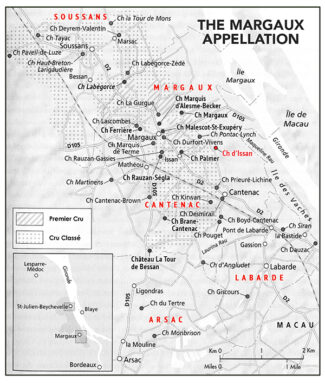
Château d’Issan Package: Six bottles; two bottles of each for $326.
CHÂTEAU D’ISSAN
The roots of Château d’Issan’ vines delve deeply into Margaux’s gravel, but not as deeply as the roots of the estate delve into history. One of the oldest producing châteaux in Bordeaux, wines from d’Issan vineyards were used to toast the marriage of Eleanor of Aquitaine and King Henry the Second. Oddly perhaps, although Cabernet Sauvignon is the dominant varietal today, when d’Issan was classified as a Third Growth in 1855, the wine was produced entirely from a grape that is now all but extinct in Bordeaux: Tarney Coulant.
In 2013, Château d’Issan sold a 50% stake to Jacky Lorenzetti of Château Lilian Ladouys, Château Lafon-Rochet in Saint-Estèphe and Château Pédesclaux in Pauillac. Along with Emmanuel Cruse, the winemaking has been upgraded to include sorting tables and a new pneumatic press along with an increase of the proportion of new French oak barrels used to age the wine; currently an average of 50% of the aging barrels are seeing their first vintage.
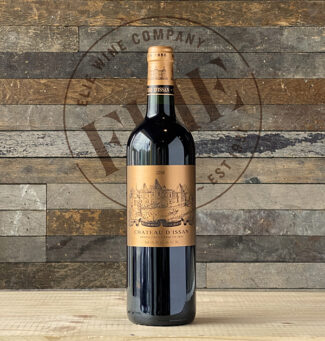 First Wine: Château d’Issan, Margaux 2018 ($99)
First Wine: Château d’Issan, Margaux 2018 ($99)
2018 D’Issan is composed of 60% Cabernet Sauvignon and 40% Merlot, half of it aged in new oak and half in second-year barrels for an estimated 18 months. A deep garnet color, it offers blackberry compote, warm cherry pie and cassis with spice box and fragrant earth plus hints of tea behind a core of firm, fine-grained tannins.
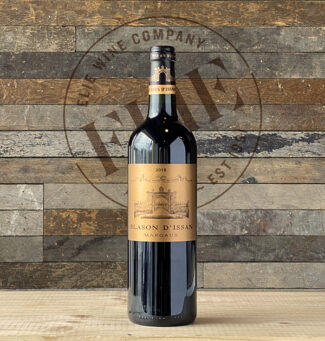 Second Wine: Château d’Issan ‘Blason’, Margaux 2018 ($40)
Second Wine: Château d’Issan ‘Blason’, Margaux 2018 ($40)
D’Issan’s second wine, introduced in 1995, is made from the estate’s youngest vines. It is fruity and accessible, offering a bouquet of blackberry and cranberry laced with undergrowth, mint, lavender and tobacco leading to full, fruity mid-palate and a mineral-driven finish.
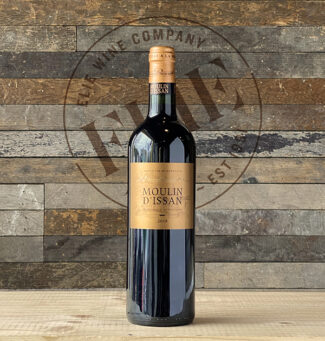 Third Wine: Château d’Issan ‘Moulin d’Issan’, Bordeaux Supérieur 2018 ($24)
Third Wine: Château d’Issan ‘Moulin d’Issan’, Bordeaux Supérieur 2018 ($24)
Bordeaux Supérieur (mostly red wines) is an appellation tier applied to wines made within the generic Bordeaux AOP zone, and as the name suggests, they are intended to be a ‘superior’ form of standard Bordeaux AOP wines and rely heavily on Merlot and Cabernet Sauvignon with smaller amounts of Cabernet Franc, Petit Verdot and Malbec.
Moulin d’Issan is silken and sweet; and with 90% Merlot the wine is gentle on the nose and shows tart cherry and raspberry with an underflow suggesting tobacco leaf and integrated chocolate. It’s mouth-filling and briefly luscious, offering the trademark Château d’Issan Margaux framework at a fraction of the cost.
Paulliac: Elegance and Power Coupled with Complexity
Whereas the Right Bank of the Gironde is known for clay-rich soils that produce smooth, softly-fruited wines with balancing tannins, the Left Bank—where vines tend to struggle through limestone and gravel—is known for tannic wines that become exponentially more complex with age. The Left Bank encompasses the Médoc region, whose face, quite arguably, is Pauillac.
Pauillac represents three of the five First Growths named in the 1855 Classification, with another fifteen classified wines adding trophies to the wall, including two heralded Second Growths. The wines of Pauillac contain a characteristic finesse, elegance, and intensity essentially unmatched by any growing region elsewhere in the world. The maritime climate and unique soil matrix, ideally suited to Cabernet Sauvignon, is key to the splendor. Nearly flat, (the average elevation in Pauillac is twenty feet), the subsoil is often composed of alios, a hard sandstone rich in iron, which may account for the appellation’s classic strength and vitality. The châteaux, in the main, are less subdivided than in neighboring regions, making it easier to pinpoint variations in style according to terroir.
Pauillac consists of about 3000 acres of vineyards, which on average produce seven million bottles of wine per year.
Pauillac contains a dozen Fifth Growth estates, each vying to match fame of Château Lynch-Bages, long considered the leader in the category, dubbed ‘the poor pan’s Mouton’ for its rich and powerful style. Among those who consistently outperform their classification, especially in recent years, is Château Pédesclaux, thanks to Jacky, Françoise and Manon Lorenzetti’s commitment to organic viticulture and the addition of state-of-the-art cellar technology. Says wine critic Jeb Dunnuck: “This estate has made leaps and bounds in terms of quality over the past decade, and my money is on the 2018 Château Pédesclaux being the best to date.”

Château Pédesclaux Package: Six bottles; three bottles of each for $294.
CHÂTEAU PÉDESCLAUX
Pédesclaux is classified as a Fifth Growth, and the original accuracy of that designation may be confirmed by the fact that the Pédesclaux family was well-regarded as négociants at the time, and Edmond Pédesclaux was one of the brokers who actually helped determine the 1855 Classification. That said, there has not been a Pédesclaux at the helm since the nineteenth century, but the various owners since have slowly but steadily improved the plots they owned while purchasing additional vineyards. Part of the overall plan has involved rebalancing the vineyards, adding more Cabernet Sauvignon (to which the terroir, Garonne gravel on subsoil of limestone, is particularly suited) and removing rows of Merlot. The current breakdown of the vineyards is 48% Merlot, 47% Cabernet Sauvignon, 3% Petit Verdot, 2% Cabernet Franc.
To the Lorenzetti family, who took over the estate in 2009, land stewardship is paramount; all vineyards are farmed organically and certain plots, biodynamically. Respect for the environment has been at the heart of their approach to viticulture. Once they had restructured the existing vineyards and purchased several high-quality plots atop the Milon plateau (where their rows are interspersed with those of Mouton and Lafite), they introduced exacting and sustainable farming methods to improve the land, and the results are evident in the bottlings, which in recent years far outgun the châteaux’s classification.
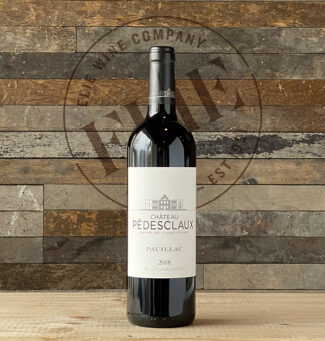 First Wine: Château Pédesclaux, Pauillac 2018 ($67)
First Wine: Château Pédesclaux, Pauillac 2018 ($67)
64% Cabernet Sauvignon, 27% Merlot, 5% Cabernet Franc, 4% Petit Verdot, the wine shows a solid core of cassis and blackberry liberally framed by dark cocoa and espresso notes which carries through a spice and licorice finish.
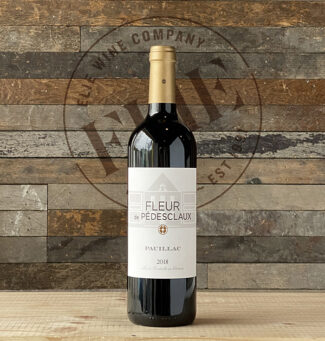 Second Wine: Château Pédesclaux ‘Fleur de Pédesclaux’, Pauillac 2018 ($31)
Second Wine: Château Pédesclaux ‘Fleur de Pédesclaux’, Pauillac 2018 ($31)
59% Cabernet-Sauvignon, 36% Merlot, 3% Petit Verdot, 2% Cabernet Franc from a 120-acre plot, the estates 2018 second wine is characterized by its higher percentage of Merlot, leading to a rich nose of wild blackberries and garrigue, showing wild strawberries and supported by spicy notes of cedar, camphor and pepper. The palate, delicate and fresh, is laced with velvety tannins.
In-Store Tasting (RSVP Required)
Left-Bank Rendez-Vous with Augustin Lacaille
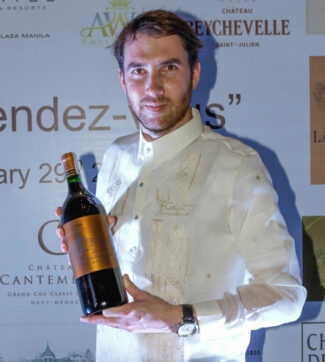 As a special expression of thanks to valued patrons who have supported us over the years, Elie Wine Company is proud to extend an invitation to a special in-store tasting on Monday May 9 from 5:30pm to 7:30pm. With our guest Augustin Lacaille, the charismatic commercial director of the Left Bank châteaux; Château d’Issan, Château Pédesclaux, Château Lafon-Rochet and Château Lilian Ladouys, we will make a vinous trail through the four great Châteaux each of whom offers exceptional quality and remarkable value.
As a special expression of thanks to valued patrons who have supported us over the years, Elie Wine Company is proud to extend an invitation to a special in-store tasting on Monday May 9 from 5:30pm to 7:30pm. With our guest Augustin Lacaille, the charismatic commercial director of the Left Bank châteaux; Château d’Issan, Château Pédesclaux, Château Lafon-Rochet and Château Lilian Ladouys, we will make a vinous trail through the four great Châteaux each of whom offers exceptional quality and remarkable value.
- - -
Posted on 2022.05.07 in Margaux, Pauillac, France, Bordeaux, Saturday Sips Wines, Wine-Aid Packages
Featured Wines
- Notebook: A’Boudt Town
- Saturday Sips Wines
- Saturday Sips Review Club
- The Champagne Society
- Wine-Aid Packages
Wine Regions
Grape Varieties
Aglianico, Albarino, Albarín Blanco, Albarín Tinto, Albillo, Aleatico, Arbanne, Aubun, Barbarossa, barbera, Beaune, Biancu Gentile, bourboulenc, Cabernet Franc, Cabernet Sauvignon, Caino, Caladoc, Calvi, Carcajolu-Neru, Carignan, Chablis, Chardonnay, Chasselas, Clairette, Corvina, Cot, Counoise, Erbamat, Ferrol, Fiano, Frappato, Friulano, Fromenteau, Fumin, Garnacha, Gewurztraminer, Godello, Graciano, Grenache, Grolleau, Groppello, Juan Garcia, Lambrusco, Loureira, Macabeo, Macabou, Malvasia, Malvasia Nera, Marsanne, Marselan, Marzemino, Melon de Bourgogne, Merlot, Mondeuse, Montanaccia, Montepulciano, Morescola, Morescono, Moscatell, Muscadelle, Muscat, Natural, Nero d'Avola, Parellada, Patrimonio, Petit Meslier, Petit Verdot, Pineau d'Aunis, Pinot Auxerrois, Pinot Blanc, Pinot Gris, Pinot Meunier, Pinot Noir, Poulsard, Prieto Picudo, Rondinella, Rousanne, Roussanne, Sangiovese, Sauvignon Blanc, Savignin, Semillon, Souson, Sparkling, Sumoll, Sylvaner, Syrah, Tannat, Tempranillo, Trebbiano, Trebbiano Valtenesi, Treixadura, Trousseau, Ugni Blanc, vaccarèse, Verdicchio, Vermentino, Viognier, Viura, Xarel-loWines & Events by Date
- April 2024
- March 2024
- February 2024
- January 2024
- December 2023
- November 2023
- October 2023
- September 2023
- August 2023
- July 2023
- June 2023
- May 2023
- April 2023
- March 2023
- February 2023
- January 2023
- December 2022
- November 2022
- October 2022
- September 2022
- August 2022
- July 2022
- June 2022
- May 2022
- April 2022
- March 2022
- February 2022
- January 2022
- December 2021
- November 2021
- October 2021
- September 2021
- August 2021
- July 2021
- June 2021
- May 2021
- April 2021
- March 2021
- February 2021
- January 2021
- December 2020
- November 2020
- October 2020
- September 2020
- August 2020
- July 2020
- June 2020
- May 2020
- April 2020
- March 2020
- February 2020
- January 2020
- December 2019
- November 2019
- October 2019
- September 2019
- August 2019
- July 2019
- June 2019
- May 2019
- April 2019
- March 2019
- February 2019
- January 2019
- December 2018
- November 2018
- October 2018
- September 2018
- August 2018
- July 2018
- June 2018
- May 2018
- April 2018
- March 2018
- February 2018
- January 2018
- December 2017
- November 2017
- October 2017
- September 2017
- August 2017
- July 2017
- June 2017
- May 2017
- April 2017
- March 2017
- February 2017
- January 2017
- December 2016
- November 2016
- October 2016
- September 2016
- August 2016
- July 2016
- June 2016
- May 2016
- April 2016
- March 2016
- February 2016
- January 2016
- December 2015
- November 2015
- October 2015
- September 2015
- August 2015
- July 2015
- June 2015
- May 2015
- April 2015
- March 2015
- February 2015
- January 2015
- December 2014
- November 2014
- October 2014
- September 2014
- August 2014
- July 2014
- June 2014
- April 2014
- March 2014
- February 2014
- January 2014
- December 2013
- November 2013
- October 2013
- September 2013
- August 2013
- July 2013
- June 2013
- May 2013
- April 2013
- March 2013
- February 2013
- January 2013
- December 2012
- November 2012
- October 2012
- February 2004
Search



